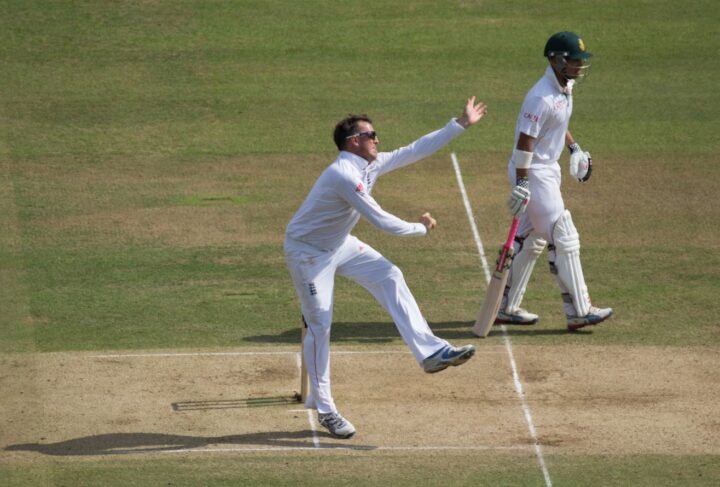It’s guest post time today. After England’s shocking (or should that be not so shocking) collapse on Tuesday, Sam MacDonald asks whether T20 has changed test cricket – and if so, is this a good thing? Over to you Sam …
When Ben Stokes thrashed the quickest double century by a Englishman in Test cricket it felt like something had changed. Perhaps that’s just my perception – maybe the modern game changed when Kevin Pietersen played the reverse slog sweep, or when the Australians started scoring at 4 runs per over in the early 2000s – but that’s how it felt. Even England, us traditionalist stick-in-the-muds, are now playing an attacking form of cricket.
I’m not sure whether this ultra positive cricket brought about T20 or vice versa, but things have certainly changed since the shortest form of the game was born. Now it seems entirely normal for test batsmen to score big runs in far fewer balls than they faced. The fans certainly love it. Watching Ben Stokes smoke the ball everywhere was so exciting that even Graeme Smith was smiling. Geoffrey Boycott even put his stick of rhubarb away.
The downside to all this, however, is that batsmen don’t seem to defend as well as they used to. When the bowler is on top they try to counter-attack, and this can look quite messy when it goes wrong. Exhibit A: England’s dismal effort in the second innings in the 4th test against South Africa.
Of course, England collapses are nothing new. But there have also been times when England gritted their teeth and fought hard for a draw. Remember Atherton and Russell against South Africa in 1995, or Collingwood’s many Brigadier Block marathons?
I wonder if the current crop of English batsmen are actually capable of curbing their natural instincts and securing a nail-biting draw? I know some of them can – good old Cooky and Compton could bore the life out of Chris Tavare if required, but I’m not so sure about Hales, Stokes, Bairstow and the others.
Perhaps it’s just the old KP dilemma: marvel when he smashes it everywhere (and humiliates the bowler) and despair when he gets out playing a horrible shot? Maybe its’s simply too much to expect batsmen to alternate between an exhilarating tempo, playing seat-of-your-pants shots, to an ultra defensive mode? The latter requires a completely different mind-set and an exceptional defensive technique.
Whatever the case, I think T20 has accelerated our appetite for high-risk cricket in longer forms of the game. Is test cricket is better for it? I suppose that’s down to personal taste. Maybe there have been good consequences and bad. But watching supposedly high quality batsmen slog hopelessly at good length balls while trying to save a test match makes me wince. This certainly isn’t the beautiful game I’ve grown up with. Maybe I’m just getting old?
Consequently it’s time for a call to arms. Perhaps us traditionalists should remove our monocles, put down our victoria sponges, and start a new and exciting (though ultimately lethargic and ineffective) movement to save traditional test cricket. We could follow the example set by the trailblazing slow food movement, which reveres traditional methods of cooking. Maybe Boycott and Tavare could be persuaded to front the campaign, with stylish photography capturing the pure ecstasy of a perfectly perpendicular forward defensive stroke.
Or maybe not.
Sam MacDonald









Dear Sam
If you start the movement I’m sure there will be plenty of fans to join it. I think there are many like me who are becoming tired of hearing every attacking shot called “exciting” no matter what the match situation. The nuances of cricket deserve better. The days of blocking and fighting back to save a game are spectacularly tense as every spectator knows. Not only games can hang on exceptional skills of survival but whole Series. There will come a time when the Ashes will be thrown away through the lack of them. Collingwood was also an attacking batsman as well as being Brigadier Block. Last time round in South Africa he and Bell both put their strokes away at Newlands and fought for nearly five hours to save the game. They were pummelled by Steyn and Morkel at their very best but didn’t flinch. That is also great cricket. Colly got 40 (188 balls) Bell 78 (213 balls). Too few tributes are paid to that day although at the time the media sweated through the day with the rest of us. Bell fell just 17 balls short having seen wickets fall around him. Onions walked out to hold the fort with Swann in the last over. What drama! We don’t only want deeds of daring-do remembered but deeds of endurance and skill. There is no glory in going down without a fight. Poetry is often called the right words in the right place. Cricket is the right strokes in the right place at its best. Even a failed attempt at trying to save a game has glory. Certainly CMJ thought so. Bell fought for nearly a day at Kandy against the spin of Murali, partnered by Prior for the last couple of hours, but finally fell together defeated after Murali devilishly took the new ball. CMJ praised “the noble romance” of the partnership. The romance of the great stands should not be forgotten, otherwise cricket will just become a shadow of its past. Classical stroke play is also in danger of being a victim of t20. What a pleasure it was to watch Bavuma play so beautifully for his runs, it was really thrilling to see him unfurl those cover drives against our bowlers. What up and coming English batsman will replace Bell’s divine stroke play?
Amen!
I do agree. There has to be a middle course. The fighting draw is an integral part of Test cricket and can be highly exciting in its own right. After three excellent matches, England fans were crumpled by a display of almost total ineptitude.
It has to be about mindset as much as technique but technique is important as Hales is showing in Test cricket. This is an issue that may accelerate as more players come into the game on the basis of T20 prowess.
I am not sure we will see too many David Warners – starting in T20 and adapting his game to Tests . More likely an increasing number of confused Buttlers and Haleses? Warner seems to me to be a fine player. Opening and scoring a 100 every third test at a strike rate of 77 or whatever. He is at least as valuable a player as Root or his Smith but seldom gets the same recognition. Not the chap to take home to mother perhaps but… My point is that he is close to exceptional and one is fearful of finding too many others.
Meanwhile we still have not replaced Strauss or Collingwood – neither glamorous but we would give a lot to have either in their better form in the side. Attacking cricket is great but it has its limits when the game is designed to be over 400 overs rather than 40. England need to find and pick a team where a sufficient number can bat for long periods and also cope with less than ideal conditions. It’s all about balance (but not necessarily Ballance?), isn’t it?
Completely agree about Warner-a very good example although Australia have more pedigree in aggressive batting department possibly because their pitches favour that kind of batting more.Yes exactly please not 1.Cook 2.Compton 3.Ballance!
Thanks Jackie that’s a beautiful love-letter to cricket.If you want a batsmen who is almost as elegant as Bell how about James Vince who could bat at three if Hales drops out?
I agree with most of what you said but I don’t think you could put Collingwood or Bell in the same bracket as some of the new England team in terms of aggressiveness.But perhaps Matt Prior is more out the ‘see ball hit ball catergory’ who could also block out.
T20 Cricket has definitely affected the other two formats of the game. The most successful and regular T20 series in the world is no doubt IPL. you can see the difference in Indian cricket before and after IPL. Now their average scoring rate has increased. Their batsman made some great record. Earlier only Sachin Tendulkar used to make records now other young batsman are performing extremely well. With more T20 leagues it has to even impact Test cricket further when we will see teams making 300+ runs on a single day
Why do we want 300+ in a day at a test match?? If all you want are quick runs and/or quick wickets then watch white ball cricket.
Why do we associate ‘entertainment’ with massive runs?? Nothing worse than a run fest test match. The best tests are when a ‘great’ innings gets 400 and the norm is 300-340 first dig and then struggling for either side to make 250’second dog due to wicket being hard to play on (ie, spinning or variable bounce etc).. Make a 100 in an test rarer, not like now when it’s sometimes almost a formality the wickets are so flat and world bowling stocks are so low
Warner appears good because he spends most of his time batting on batting paradises where throwing your hands through the ball are rewarded. Now, he is actually much bette than a hales, dhawan etc, but he is a one day batsmen masquerading in an poor era of flat tracks, lesser bowlers era.
Test cricket should be high level, high skill format. Unfortunately IMO it’s suffering because players aren’t able to adapt from white ball cricket. You can see it in the likes of kohli (who despite Indian protests isn’t the player in tests he’s made out to be), smith, Warner, root, stokes etc. So so few true test batsmen around now.
We have no hope of it returning because where are the test techniques, mentalities, ability to grind and a love for a fighting draw going to be fostered in new players?? Everyone I know pretty much plays win lose cricket.. Meaning no one is learning to bat properly, merely becoming a hitter.
I love test cricket, I dislike 2020 and odi’s and also think the media destroy the test game because anything other than hitting is mundane and a stokes like hit through the line is ‘entertaining’.. I’d have got more out of a tense fighting draw in the last test than watch stokes smash a poor attack around a flat deck.. If I want to see that cricket, I’ll watch 2020.
I do fear for the game, losing amateurs at an alarming rate, skill of amateurs dropping, skill of county pros dropping and he level of tests dropping. I just can’t see how it can recover
“Warner appears good because he spends most of his time batting on batting paradises…. he is a one day batsmen masquerading in an poor era of flat tracks, lesser bowlers era”.
This wasn’t a flat track (next highest score in the match 56!) :
http://www.espncricinfo.com/ci/engine/match/518948.html
This wasn’t a lesser bowling attack:
http://www.espncricinfo.com/ci/engine/match/648677.html
These weren’t easy runs:
http://www.espncricinfo.com/ci/engine/match/727927.html
Australia have played on some extremely batsman-friendly home pitches in the last two seasons and these have inflated Warner’s record somewhat – but he is still a fine player with a very good record in varied conditions. I wouldn’t want a top six all of David Warners but I think virtually every top six could find a space for him. The only team of my forty years watching cricket that he wouldn’t get into would be peak Steve Waugh-Ricky Ponting era Australia where I wouldn’t select him ahead of Langer or Hayden and there was no space to drop anyone down the order.
Also, for a supposed one-day specialist, Warner’s ODI and T20I records aren’t when you look at them really that great.
Yes, I’ve noticed the influence of T20 on test cricket. I still think test cricket is the most absorbing but I’m modest enough to accept that cricket is not played solely to satisfy me.
I have observed that a ball delivered slightly outside off stump and cautiously left alone will garner gurgles of delight from Nasser and Athers but will be stroked to to the boundary by the same batsman when it’s a white one – those two will comment that the bowler is giving the batsman too much width.
I actually think the two formats should and to some extent do learn from each other.
Still my favourite cricket moment is when Botham “took the game” to the Aussies in 1981. You need all the skills in top cricket.
very nice information……….
I think T20 has had some impact, its made batsmen braver for a start and more daring to try things.
However it ultimately comes down to conditions. I didn’t see much evidence of T20’s influence in our recent series in the UAE or in the Caribbean. However I don’t particularly enjoy watching test cricket in 3 days.
The best test match in my recent memory was the Adelaide D/N match. Yes it was over in 3 days but it had something for everyone. Whether T20 had anything to do with the speed of that game I’m not sure.
If most test matches had a scenario where the side batting 1st scores 350-400 in 100 overs, we’d have a very healthy format. There is room for the odd 200 plays 200 (see Adelaide) but I don’t want to see many 600 plays 500.
Sorry my words got jumbled there.
I meant to say I don’t particularly enjoy watching test cricket in those circumstances. (Mind racing ahead)
I tend to agree. I like test match pitches that create a fair contest between bat and ball, where totals of 320-350 are par, and 400 in the first innings is considered to be a very healthy. I’d like to burn the kookaburra ball and fine groundsmen who produce complete roads. There’s nothing worse than watching 600 play 600, with bowlers toiling in the heat. Test cricket is at its best when a team is chasing 220 on a deteriorating pitch on days 4 and 5. Brilliant entertainment.
Sadly the Duke ball reportedly lasts half as long as a Kookaburra in Australian conditions, so a completely new option for pretty much anywhere bar England & NZ is needed.
Overall Test Strike Rates by decade:
1950s 35.7
1960s 40.2
1970s 40.9
1980s 44.0
1990s 43.8
2000s 49.5
2010s 50.9
So there is a move upwards but (perhaps surprisingly) only very slightly in this decade. It seems reasonable that T20 was one of the reasons for the jump in the 2000s (T20 started, I think, in 2003) but it wouldn’t be the only one ( an era of generally weaker bowling and faster outfields are two others I’d suggest).
I think weak bowling is a key point
I don’t care how good Sehwag, Warner, KP and the like are, they wouldn’t have smashed Garner, Marshall, Wasim & Waqar to all parts.
The curious thing is going to be whether weak bowling is merely cyclical (the 1930s, for example, saw something similar) or a more permanent shift in the balance of the game. I think there are legitimate grounds to fear it might be the latter.
Like a lot of people who comment on blogs I suspect, I used to identify and be more interested in batting. Such abysmal cricket as I played myself was as a batsman. The older I get, the more I’m starting to think that bowling is the more fascinating part of the game – and the players I have the most affection for are more bowlers than batsmen.
I started to get into cricket in the mid to late 80’s. The era of the fast bowler
My favourite player was Hick, I was convinced he’d come in a put these bowlers in their place.
But he faced this run of players.
91. Ambrose & Marshall
92. Wasim & Waqar
93. Alderman & Hughes
94. Donald & De Villiers
I was spoiled by watching great fast bowlers and two of the finest spinners (Warne & Murali)
What we have now is no comparison.
I hope its not terminal, but flat decks may mean it is.
Why would a young West Indian want to slog in that heat on those puddings?
Why would any young Indian want to grow up to be cannon fodder in the IPL?
Australia have had a good crop recently, but then produce decks like they did at the Gabba & the WACA this year. Inspiring nobody.
We keep producing that Lords wicket.
The showpiece test in SA this series was played on a road.
Bowling’s not much fun on these.
There is nothing intrinsically displeasurable about bowling in T20s. I love bowling in T20s. You’re only cannon-fodder if you’re shit.
Apart from when some slogger just swings through the ball and connects and keeps,edging you for 4/6 or depositing it in the crowd.. Not a good shot but that’s 2020, it’s purely about swinging and biffing.
I’ve simply retired from 2020 and I’m only 32 becUse it’s a waste of a few hours for little actual game time, let alone annoying when you watch poorer techniques prosper
The last perfectly perpendicular forward defensive stroke I saw was executed by Temba Bavuma. Maybe there’s hope?